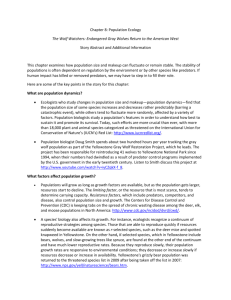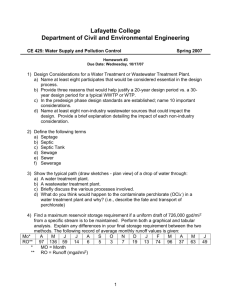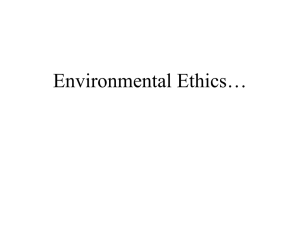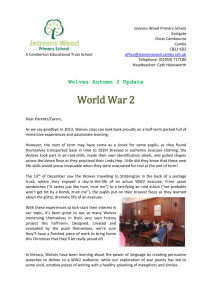Doc version - College of Computing
advertisement
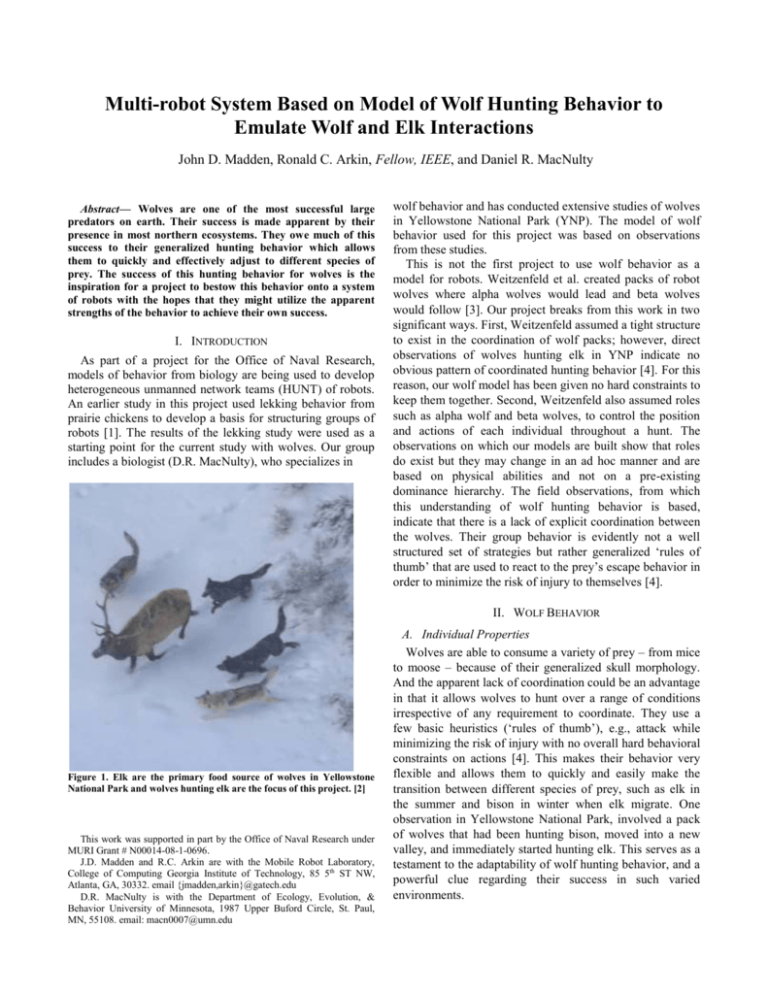
Multi-robot System Based on Model of Wolf Hunting Behavior to
Emulate Wolf and Elk Interactions
John D. Madden, Ronald C. Arkin, Fellow, IEEE, and Daniel R. MacNulty
Abstract— Wolves are one of the most successful large
predators on earth. Their success is made apparent by their
presence in most northern ecosystems. They owe much of this
success to their generalized hunting behavior which allows
them to quickly and effectively adjust to different species of
prey. The success of this hunting behavior for wolves is the
inspiration for a project to bestow this behavior onto a system
of robots with the hopes that they might utilize the apparent
strengths of the behavior to achieve their own success.
I. INTRODUCTION
As part of a project for the Office of Naval Research,
models of behavior from biology are being used to develop
heterogeneous unmanned network teams (HUNT) of robots.
An earlier study in this project used lekking behavior from
prairie chickens to develop a basis for structuring groups of
robots [1]. The results of the lekking study were used as a
starting point for the current study with wolves. Our group
includes a biologist (D.R. MacNulty), who specializes in
wolf behavior and has conducted extensive studies of wolves
in Yellowstone National Park (YNP). The model of wolf
behavior used for this project was based on observations
from these studies.
This is not the first project to use wolf behavior as a
model for robots. Weitzenfeld et al. created packs of robot
wolves where alpha wolves would lead and beta wolves
would follow [3]. Our project breaks from this work in two
significant ways. First, Weitzenfeld assumed a tight structure
to exist in the coordination of wolf packs; however, direct
observations of wolves hunting elk in YNP indicate no
obvious pattern of coordinated hunting behavior [4]. For this
reason, our wolf model has been given no hard constraints to
keep them together. Second, Weitzenfeld also assumed roles
such as alpha wolf and beta wolves, to control the position
and actions of each individual throughout a hunt. The
observations on which our models are built show that roles
do exist but they may change in an ad hoc manner and are
based on physical abilities and not on a pre-existing
dominance hierarchy. The field observations, from which
this understanding of wolf hunting behavior is based,
indicate that there is a lack of explicit coordination between
the wolves. Their group behavior is evidently not a well
structured set of strategies but rather generalized ‘rules of
thumb’ that are used to react to the prey’s escape behavior in
order to minimize the risk of injury to themselves [4].
II. WOLF BEHAVIOR
Figure 1. Elk are the primary food source of wolves in Yellowstone
National Park and wolves hunting elk are the focus of this project. [2]
This work was supported in part by the Office of Naval Research under
MURI Grant # N00014-08-1-0696.
J.D. Madden and R.C. Arkin are with the Mobile Robot Laboratory,
College of Computing Georgia Institute of Technology, 85 5th ST NW,
Atlanta, GA, 30332. email {jmadden,arkin}@gatech.edu
D.R. MacNulty is with the Department of Ecology, Evolution, &
Behavior University of Minnesota, 1987 Upper Buford Circle, St. Paul,
MN, 55108. email: macn0007@umn.edu
A. Individual Properties
Wolves are able to consume a variety of prey – from mice
to moose – because of their generalized skull morphology.
And the apparent lack of coordination could be an advantage
in that it allows wolves to hunt over a range of conditions
irrespective of any requirement to coordinate. They use a
few basic heuristics (‘rules of thumb’), e.g., attack while
minimizing the risk of injury with no overall hard behavioral
constraints on actions [4]. This makes their behavior very
flexible and allows them to quickly and easily make the
transition between different species of prey, such as elk in
the summer and bison in winter when elk migrate. One
observation in Yellowstone National Park, involved a pack
of wolves that had been hunting bison, moved into a new
valley, and immediately started hunting elk. This serves as a
testament to the adaptability of wolf hunting behavior, and a
powerful clue regarding their success in such varied
environments.
B. Breakdown of a Wolf Hunt
As is the case for most large carnivores, the predatory
behavior of wolves is composed of multiple phases of
behavior or foraging states. Traditionally, only three states
are considered: search, pursuit, and capture [5]. In this
research, however, a modified ethogram with six states has
been adopted: search, approach, watch, group attack,
individual attack, and capture, as proposed in [6]. Here,
MacNulty concluded that the additional states represent
“functionally important behaviors”, and for robotics, this
more detailed ethogram lends itself more easily to software
implementation. The wolf packs studied to form this
ethogram were located in Yellowstone National Park,
hunting elk and American Bison. The focus of the first phase
of the robotics implementation involves a model of wolves
hunting elk. The following is a description of a typical hunt
with wolves and elk. A diagram showing the typical
progression through foraging states is given below in Figure
2.
Figure 2. The progression of transitions between states seen in a typical
hunt with wolves and elk.
TABLE 1
Foraging States for Wolf Hunting Behavior
Foraging State
Description
Search
Traveling without fixating on and moving
toward prey
Approach
Fixating on and traveling toward prey
Attack Group
Running after a fleeing group or lunging at a
standing group while glancing about at different
group members (i.e., scanning)
Attack Individual
Running after or lunging at a solitary individual
or a single member of a group while ignoring all
other group members
Capture
Biting and restraining prey
When a hunt is initiated, the wolf pack heads out from its
den or resting site and begins searching for prey. Hunger
motivates the initiation of a hunt [8]. What direction the
wolves go and to what extent they are willing to travel are
dependent on their experience of prior successes and
failures. As they search they make use of their strong senses,
using the wide range of their lateral vision and their movable
ears, to scan the landscape for potential prey. Once prey has
been located, they start approaching.
Assuming that that the pack has located a relatively
stationary herd of elk, the wolves approach at moderate
speed. In general, wolves do not sneak up on their prey, nor
do they target a specific individual from the herd until after
the herd begins running. Species that use this approach
strategy are known as cursorial predators and it is the
principal difference separating their hunting behavior from
that of other large predators such as lions [6]. In response to
approaching wolves elk will either stand their ground or to
run away. Elk most commonly run away which usually leads
to the ‘attack group’ state.
As the prey quarry run away, they split up into groups
headed in different directions and the wolves must also split
up to follow as many as they can. During this stage of the
hunt the wolves are scanning through the groups of prey,
trying to locate the weakest individual that will provide the
best opportunity for a kill. An advantage of running the
animals to exhaustion is that it creates opportunities for the
prey animals to make a fatal mistake (i.e., tripping). It also
provides a useful test of performance by which the wolves
can evaluate which animal is the weakest [8]. When a weak
animal is detected by a wolf, that wolf then transitions to the
‘attack individual’ state.
The ‘attack individual’ state is characterized by
intensified pursuit and greater focus on the targeted prey
individual. Other wolves may see the pursuit of this wolf
and join in, but that is not necessarily the case. Coordination
of multiple wolves (or lack thereof) is discussed in the next
section. The goal of this behavioral state is for the wolf to
get close enough to the prey to begin biting it in an attempt
to bring it down. Whether it is a single wolf or a number of
wolves, biting the prey signifies a transition to the capture
state.
The ultimate goal of the capture state is killing the prey.
If the prey animal is small (i.e., a calf) the first wolf may
attack the throat directly since it can easily handle the animal
by itself. If the prey is larger and there are many wolves,
they will often bite at the hind legs and rump attempting to
slow their prey down before grabbing the neck. This project
is not concerned with the mechanics of how wolves bring
down prey but it is important to note that there are
differences in attacking different prey. If the prey truly was a
weak individual, the wolves will most likely complete a
successful kill, but if they had misperceived a strong animal
as weak, they may fail and either give up on the hunt or
transition back to an earlier state.
The narrative of a hunt that has just been related gives a
general idea of how many specific individual hunts progress
through these foraging states; however, it is often not this
clear cut. Many other transitions are possible aside from the
seemingly linear straightforward progression from search, to
approach, then attack group, attack individual, and finally
capture. For instance, wolves primarily attacked groups after
approaching but “they also sometimes attacked elk groups
immediately after discovering or watching the group” [6].
MacNulty et al. compiled their statistical observational data
of state transitions (Table 2) where the tabular values
represent the probability of transition between states. Notice
that the transitions chosen for the description of the linear
hunt above are those of highest probability in the table.
unaware that they need the others to help them take down
the large prey because this is most often the case. It may not,
however, be required that wolves need help to take down
any of their usual prey. It is proposed that one of the biggest
reasons that large terrestrial predators do not use group
coordination is that they do not necessarily need it. Solitary
hunters have a high success rate, roughly 21% for most large
carnivores [MacNulty unpublished data].
III. IMPLEMENTATION OF WOLF BEHAVIOR
TABLE 2
Probabilities of Transitions Between States From [6]
Following State
Preceding
State
Search
Approach
Watch
Attack
Group
Attack
Individual
Capture
Search
Approach
.00
.09
.68
.00
.00
.12
.31
.69
.01
.09
.00
.01
Watch
.32
.35
.00
.27
.06
.00
.24
.09
.03
.13
.51
.00
.16
.06
.02
.16
.08
.52
Attack
Group
Attack
Individual
Thus far, the ‘watch’ state has been neglected as it is a
rare state for wolves to enter when attacking elk; as seen in
the table above, the highest probability of entering the
‘watch’ state is 12% from ‘approach’. For this reason, the
‘watch’ state has been left out of the ethogram for our
robotics implementation described in Section III.
C. Coordination or Lack Thereof
Wolves are generally perceived by the public to be highly
coordinated hunters using strategies and teamwork to bring
down large prey. Over two thousand hours of observed wolf
behavior in Yellowstone Park seem to prove otherwise [4].
According to these observations, wolves not only show no
signs of planned strategies but also little to no noticeable
communication while hunting. This is evidenced by the fact
that wolves hunting the same herd do not make transitions
between states together (i.e., one may find a weak prey and
transition to attack that individual while the others remain in
an attack group). The disparity in these transitions goes so
far as to see one wolf having killed an animal and begin
eating it while the others persist in the ‘attack group’ state.
Furthermore, in this last example, the wolf that made the kill
did not appear to make any attempt to signal the others of its
success.
The seemingly coordinated wolf hunting behavior is most
likely the result of “byproduct mutualism” where each
individual is simply trying to maximize its own utility. It is
hypothesized that wolves see the fact that other wolves are
chasing an elk as a sign of weakness of that prey animal and
from that stimulus determine that they have the best chance
of a meal if they join in the pursuit of that animal. Even far
greater size of their prey does not force wolves to rely on
teamwork; according to MacNulty, some aggressive wolves
would attack even large bison alone. It is possible that such
wolves simply assume the others will help them, or they are
Experiments for this project were conducted with
simulated robots in MissionLab1, a software package
developed by the Mobile Robotics Laboratory at Georgia
Tech [9,10]. MissionLab provides a graphical user interface
where the user specifies behavioral states that control each
robot’s actions, and perceptual triggers that control the
transitions between states, yielding a finite state acceptor
(FSA). The behaviors created for the current project can be
combined with other pre-existing behaviors such as obstacle
avoidance, moving toward an object, or noise (random
wandering). This allows for assemblages of behaviors to be
created and connected in the FSA to create arbitrarily
complex missions [11,12].
Reducing the overall hunting behavior of wolves into the
five foraging states related earlier, facilitated implementation
where each behavioral state represents a corresponding state
for the robot. These states, together with a few others added
for initial configuration and termination of experiments,
were used to create the FSA shown in Figure 3. The
perceptual conditions that must be met in order for a wolf to
transition from one state to another are known as releasers.
For instance, for the wolf to switch from the search state to
the approach state the wolf must of necessity have found
prey to approach; therefore, we say the presence of prey is a
releaser to transition to the approach state. These are
encoded as perceptual triggers in MissionLab. A list of the
releasers used in this implementation and the transitions they
facilitate are given in Table 3. The system of releasers would
normally be enough to define the transitions in a MissionLab
FSA except that often, multiple transitions are possible from
the same state to many others. In nature, what decides which
transition is chosen is a combination of situational factors
such as the number of wolves in the pack, the number of
prey individuals in the herd, terrain features, as well as the
wolf’s individual attributes such as age, weight, and
personality (i.e., aggressive individuals are more likely to
move more quickly toward capture). While these factors will
be incorporated directly in later work, for now their affect
was indirectly computed by using the probabilities of
transitions of observed wolf behavior described earlier in
Table 2.
1
MissionLab is freely available for research and educational purposes at:
http://www.cc.gatech.edu/ai/robot-lab/research/MissionLab/
Figure 3. Finite State Acceptor for Wolf behavior with five foraging state (watch state removed) as well as initial and final states for
experimentation purposes. The stop states connected to each foraging state are dummy states to facilitate the probabilistic trigger.
TABLE 3
List of Releasers and Transitions
Releaser
Transitions possible
Prey Found
S A, G, I
Prey Lost
A, G, I, C S
Multiple Prey
S, A, I, C G
Prey Running
A G, I
Prey Stopped
G, I A ; A, I C
Weak Individual Identified
GI
Prey Close
G, I C
Search, Approach, Attack Group, Attack Individual, and Capture
abbreviated: S, A, G, I, C, respectively.
These probabilistic triggers for the FSA in Figure 3 were
created in the following fashion: for each state there is a
‘Control’ trigger leading from that state to the search state
and then another trigger leading to every other state to yield
a complete graph encompassing all possible transitions
between the 5 major behavioral states. The probabilities
from Table 2 were entered as parameters into the ‘Control’
trigger at build time, and at run time this trigger would check
which transitions had their releasers satisfied. A weighted
roulette wheel was then created by normalizing the satisfied
probabilities such that they added to one and then a random
number generated between zero and one would decide the
transition to take. Once a transition is selected, the condition
for the corresponding trigger is satisfied and that behavioral
transition occurs. If the transition selected was from any
state to the search state, the control trigger’s condition would
be satisfied and a transition to search would occur. Also
incorporated into the control trigger was a timer to force the
wolves to stay in a state for a minimum length of time based
on the observed average time wolves spent in each state
(D.R. MacNulty, unpublished data). Without this hysteresis
feature the wolves would constantly alternate back and forth
between states for which the releasers are present (a form of
behavioral dithering).
Each state in the diagram above is a combination of the
constituent pre-existing behaviors: move to object, wander,
and avoid obstacles. Move to object creates an attraction
vector from the robot to the object selected. In the search
state the selected object was friendly robots, which in this
case represent other wolves, in all other states the selected
object was elk. MissionLab uses built-in vector and
simulation specific functions, implemented in C++ code.
The move to object behavior creates a vector directed from
the center of the robot to the center of the selected object so
long as the selected object is within range to be detected.
The wander behavior creates vectors of random direction.
While in the search state, this was useful to give the wolves
the ability to explore their environment for prey. In all other
states the wander behavior was used to help the wolf
overcome situations of indecision which may occur, for
instance, when a wolf is exactly the same distance between
two elk.
Finally, the avoid obstacles behavior was added to prevent
collisions. As the robot detects obstacles, repellant vectors
are created, radiating away from the obstacle. This allows
the robot to move around obstacles while searching and in
pursuit of prey. The final vector that determines the robot’s
movement is the resultant of the vectors created by these
constituent behaviors. The degree to which each behavior
had an effect on the resultant vector is dependent on the
gain, entered by the user, for each behavior. All of the
parameters, including gains, for each state can be found in a
table in the appendix.
Although the elk being preyed upon may have defensive
behavioral strategy and coordination, the focus of the
research to date has been on the hunting behavior of wolves.
Therefore, the behavior of the elk was simplified with their
reaction to the approaching wolves as simply either stopping
or running away in a direction opposite to the wolves’
approach. To create a range of test scenarios, the elks’
behavior before the approach of wolves was varied to
simulate situations where the elk are initially stationary,
moving back and forth between multiple grazing areas, or
wandering around. An example of the FSA to control the elk
behavior for moving back and forth between two grazing
areas is given in Figure 4, showing a simple modification
that switches between an elk stopping upon seeing wolves,
or running away.
Figure 4. Example photo of potential wolf hunt.
IV. SIMULATION RESULTS
The MissionLab wolf pack simulations examined multiple
scenarios that were commonly observed with wolf hunts in
Yellowstone National Park. The underlay used for the
simulations, is from the Lamar Valley in Yellowstone
National Park where many of the actual observations of wolf
hunts were taken.
Figure 4. Finite State Acceptor of Elk behavior. If the ‘run away’
behavior is desired, remove the dotted trigger to the final stop state.
This project was conducted entirely with simulated robots;
however, future work expects to move the system to
physical robots. The platforms expected to be used are: (1)
WowWee Rovio Wi-fi robots, and (2) iRobot Creates with
the Element BAM (Bluetooth Adapter Module) as pictured
below.
Figure 5. (Top): The hunting area used for experiments with starting
location on the left, and grazing areas in the right and bottom of the
map. (Bottom): Close-up showing transitions from search to capture
for one wolf hunting one elk with stop behavior. The Straight Diagonal
line is the prey’s path between grazing areas. Underlay used for
simulation of wolves in the Lamar Valley, Yellowstone National Park
where many observations were recorded [13].
The first scenario was one on one between a wolf and an
elk, with the elk moving back and forth between grazing
areas and stopping when it perceived the wolf. The
progression of the wolf through the foraging states was
recorded for each run so that frequency of transitions could
be tabulated for comparison between states and with the
original observed probabilities. An example of a hunt run
with these parameters is given in Figure 5 with starting
location, grazing areas, and transition points in the hunt
labeled. The next scenario was created by modifying the
prey’s behavior to run away, rather than stop, when it
perceived the wolf. An example of this, also showing the
wandering pattern of the wolf, is given in Figure 6. A third
scenario had the same ‘run away’ behavior for the prey but
with one wolf and three elk Figure 7. A final scenario
involved two wolves and three elk as seen in Figure 8. For
this scenario, the number of runs that both wolves ended up
killing the same elk is compared to that of the wolves killing
different elk. This comparison is made for both situations
when the wolves discovered the elk together and when the
wolves discovered elk separately. Twenty runs were
completed for each scenario and the tabulated results of
these runs are given in Table 4.
TABLE 4
Results From Wolf Simulations
One Wolf and One Elk (Stop)
Preceding
State
Search
Approach
Attack
Group
Attack
Individual
Search
-.00
Following State
Approach Attack
Attack
Group Individual
.95
.00
.05
-.00
.88
.00
.00
.00
.00
.00
.08
.12
.00
.15
.67
Preceding
State
Search
Approach
Search
-.07
Following State
Approach Attack
Attack
Group Individual
1.00
.00
.00
-.00
.93
Attack
Group
Attack
Individual
Capture
.00
.00
.00
.00
.00
.00
.00
.07
.21
.00
.23
.49
One Wolf and Three Elk (Run Away)
Following State
Preceding
Search Approach Attack
Attack
State
Group Individual
-.73
.24
.03
Search
.04
-.75
.21
Approach
Capture
.00
.00
.07
.26
.13
.54
.00
.09
.15
.22
.13
.41
Result of hunt
Discover elk together, kill same elk
Discover elk together, kill different elk
Discover elk separately, kill same elk
Discover elk separately, kill different elk
Figure 7. Close-up showing transitions for one wolf hunting three elk
with behavior set to run away from wolf.
.00
.12
One Wolf and One Elk (Run Away)
Attack
Group
Attack
Individual
Figure 6. Transitions for one wolf hunting one elk with behavior set to
run away from wolf. Random behavior of wolf search can also be seen
previous to transition to approach.
Capture
Runs
4
9
3
4
%
20
45
15
20
The final scenario involved two wolves and three elk. The
purpose of this scenario was to examine how multiple
wolves react to multiple prey. The wolves were given a
slight attraction to one another through the move-to-object
behavior to simulate actual hunts where the wolves generally
start relatively together. This behavior made the discovery of
prey with the wolves together more common. When the
wolves came across the prey together, they most often killed
different prey individuals. This may have been due to the
confined space of the map allowing the capture of
individuals they may have otherwise been lost and forced the
pursuer to join their pack member. When they discovered
the prey separately the results were split for killing the same
or different individuals.
VI. SUMMARY AND CONCLUSIONS
Figure 8. (Top): Close-up of transitions with two wolves approaching
three elk together and separating during pursuit. (Bottom): Complete
view of hunt after the two wolves split up and kill different elk.
V. DISCUSSION OF RESULTS
Many of the resulting probabilities of transitions from the
first scenario vary from the observed probabilities because in
this scenario the prey would never run away whereas in the
wild, running is the most common reaction for the prey.
Comparison of the resulting transition probabilities from the
first and second scenarios show that by changing the prey
behavior from stopping when approached by a wolf to
running away, the change in transitions is most notable in
the transitions leading to attack. The first and third scenarios
show similar differences for the same reason. Comparison of
the second and third scenario reveals that adding multiple
elk to the hunt has a large effect on the transitions for the
obvious reason that the attack group state is only possible in
the third scenario where there are multiple elk. This is the
most realistic scenario as the vast majority of the
observations in YNP were wolves hunting multiple elk. For
this reason, the results from only the third scenario are
compared to the observed data. The probabilities of
transitions were similar to those in the observed data with
the error for the primary four transitions (SA, AG,
GI, IC) at 5%, 6%, 3%, and 11% respectively. Some
transitions showed higher errors. Simulation results showed
much lower probabilities for all transitions leading to the
search state. This is most likely due to the hunts being
confined within boundaries that often affected the elk’s
attempts to run away.
By modeling wolf hunting behavior as a set of foraging
states per the ethogram of MacNulty et al. 2007, and using a
system of releasers and roulette wheel with probabilities of
transitions, we were able to simulate interactions between
wolves and elk with a relatively high fidelity to what is
observed in the wild. The probabilities of transitions over all
scenarios were similar to those in the observed data. This is
not surprising as the observed data was used in the system
that generated these results. Although there would seem to
be an advantage in structured attack strategies, the high
variability in behavior of the wolf’s prey as well as the chaos
inherent in attempting to locate, chase down, and kill one
from a herd of hundreds of running elk would quickly cause
strict strategies to breakdown. The loose adoption of general
rules gives wolves the ability to react quickly and
effectively. The results of simulations done in this project
showed that the wolves were in fact reacting to the prey’s
behavior as evidenced by the change in transitions due to the
prey stopping or running when attacked by the wolf.
APPENDIX
This appendix provides the formulas for behaviors and
transitions as well as the associated parameters used in the
simulated wolves.
a) Probabilistic Transition: Transitions based on the
existence of releasers and probabilities to simulate
factors such as prey group size, wolf pack size, and
environmental properties.
𝑷𝑺𝒕𝒂𝒕𝒆𝒏 =
𝑷𝑺𝒕𝒂𝒕𝒆𝒏
𝒊
∑ 𝑷𝒑𝒐𝒔𝒔𝒊𝒃𝒍𝒆
𝑺𝒕𝒂𝒕𝒆𝟏 ,
𝑹 < 𝑷𝑺𝒕𝒂𝒕𝒆𝟏
𝑺𝒕𝒂𝒕𝒆𝒏𝒆𝒙𝒕 {𝑺𝒕𝒂𝒕𝒆𝟐 , 𝑹 < 𝑷𝑺𝒕𝒂𝒕𝒆𝟏 + 𝑷𝑺𝒕𝒂𝒕𝒆𝟐
⋯
⋯
where:
𝑷𝑺𝒕𝒂𝒕𝒆𝒏 = Probability of transitioning from the
current state to Staten
𝑷𝑺𝒕𝒂𝒕𝒆𝒏 = Input probability of the above transition
𝒊
taken from MacNulty et al. 2007
∑ 𝑷𝒑𝒐𝒔𝒔𝒊𝒃𝒍𝒆 = Sum of probabilities of transitions with
releasers satisfied
𝑺𝒕𝒂𝒕𝒆𝒏𝒆𝒙𝒕 = Resulting state of the transition
𝑹 = Random number between 0.00 and 1.00
b) Move-to-Object: Variable attraction to selected object.
Used for attraction between pack members and
attraction from wolf toward prey.
Vmagnitude = Adjustable gain value
Vdirection = Direction from the center of the robot to the
center of the object, moving toward the object
c)
Avoid-obstacle: Repel from object with variable gain
and sphere of influence. Used for collision avoidance.
∞,
𝒎𝒂𝒙 − 𝒅
𝑽𝒎𝒂𝒈 {
,
𝒎𝒂𝒙 − 𝒓
𝟎,
𝒅≤𝒓
𝒓 < 𝑑 ≤ 𝑚𝑎𝑥
𝒅 > 𝑚𝑎𝑥
Vdirection = Direction from the center of the robot to the center
of the obstacle, moving away from obstacle
Avoid obstacle sphere
Avoid obstacle safety margin
10
4
m
m
Wolf attack group assemblage
Move to object gain
Selected object
Wander gain
Avoid obstacle gain
Avoid obstacle sphere
Avoid obstacle safety margin
.8
Enemy
.3
.3
10
4
m
m
Wolf attack individual assemblage
Move to object gain
Selected object
Wander gain
Avoid obstacle gain
Avoid obstacle sphere
Avoid obstacle safety margin
1
Enemy
.1
.3
10
4
m
m
Wolf capture assemblage
Move to object gain
Selected object
Wander gain
Avoid obstacle gain
Avoid obstacle sphere
Avoid obstacle safety margin
.1
Enemy
0
.1
1.5
.5
m
m
REFERENCES
[1]
[2]
where:
max = Maximum obstacle detection sphere
d = Distance of robot to obstacle
r = Radius of obstacle
[3]
d) Noise: Random wander with variable gain and
persistence. Used for exploration and to overcome local
maxima, and minima.
[4]
Vmagnitude = Adjustable gain value
Vdirection = Random direction that persists for
specified number of steps
[6]
[5]
[7]
[8]
[9]
[10]
Parameter
Value
Wolf search assemblage
Move to object gain
Selected object
Wander gain
Secondary wander gain
Avoid obstacle gain
Avoid obstacle sphere
Avoid obstacle safety margin
.2
Friendly
.7
.3
.5
10
4
Wolf approach assemblage
Move to object gain
Selected object
Wander gain
Avoid obstacle gain
.7
Enemy
.4
.5
Units
[11]
[12]
[13]
m
m
B. A. Duncan, P. D. Ulam, R.C. Arkin, “Lek Behavior as a Model for
Multi-Robot Systems”
D. Smith, “Wolves Chasing an Elk,” National Park Service. Dec. 1,
2007,
<http://www.nps.gov/yell/photosmultimedia/photogallery.htm?eid=37
9961&aid=547&root_aid=547&sort=title&startRow=10#e_379961>
A. Weitzenfeld, A. Vallesa, H. Flores “A Biologically-Inspired Wolf
Pack Multiple Robot Hunting Model,” in Latin American Robotics
Symposium and Intelligent Robotic Meeting (LARS 2006), Santiago,
Chile, 26-27 Oct. 2006.
D.R. MacNulty, Presentation and Interviews, Atlanta, Georgia, May
6-7, 2010.
C.S. Holling, “The Functional Response of Predators to Prey Density
and its Role in Mimicry and Population regulation,” Memoirs of the
Entomological Society of Canada, 45: 1-62.
D.R. MacNulty, L.D. Mech, D.W. Smith, “A Proposed Ethogram of
Large-carnivore Predatory Behavior, Exemplified by the Wolf,”
Journal of Mammalogy, Vol. 88, No. 3 pp.595-605, June 2007.
R. Abrantes, “The Evolution of Canine Social Behavior 2nd Edition,”
Ann Arbor, MI: Wakan Tanka Publishers, 2005.
L.D. Mech, L. Boitani, “Wolves: Behavior, Ecology, and
Conservation,” University of Chicago Press. 2003.
Georgia Tech Mobile Robotics Laboratory, “Manual for MissionLab,”
Version 7.0, 2007.
D. MacKenzie, R.C. Arkin, J. Cameron, “Multiagent Mission
Specification and Execution,” Autonomous Robots, Vol. 4, No. 1, Jan.
1997, pp.29-57. Also appears in Robot Colonies, (eds.) R.C. Arkin, G.
Bekey, Kluwer Academic Publishers, 1997.
R.C. Arkin, “Behavior-based Robotics,” MIT Press, 1998.
R.C. Arkin, “Motor Schema-Based Mobile Robot Navigation,”
International Journal of Robotics Research, Vol. 8, No. 4, August
1989, pp. 92-112.
Figure reprinted from Google, in accordance with their guidelines
posted online. ©2009 Google – Imagery ©2009 DigitalGlobe,
GeoEye, USDA Farm Service Agency, Map data ©2009 Tele Atlas.



